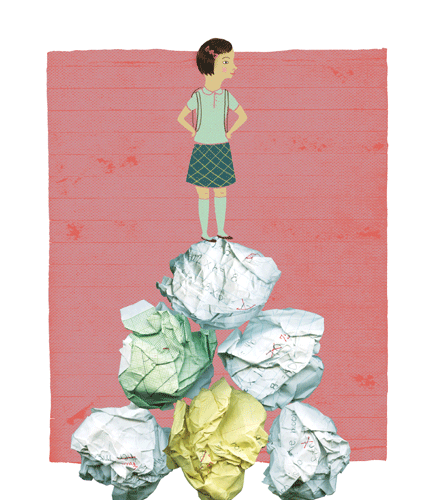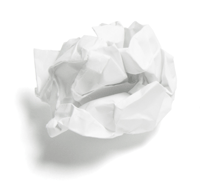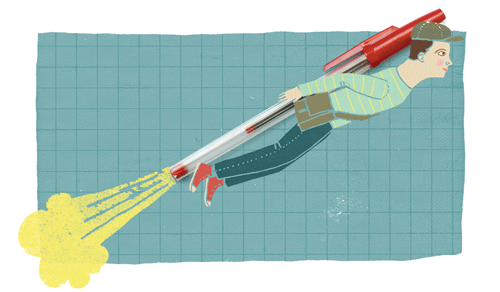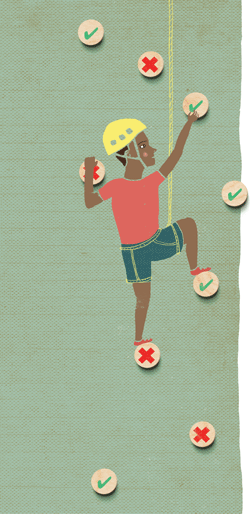School Leadership 2.0
A Network Connecting School Leaders From Around The Globe
Mistakes Were Made. And when they’re made in a classroom? Even better. BY LORY HOUGH
Mistakes Were Made
Illustrations by Catherine Lepage
 He was a cool dude, and the ladies loved him. But even the Fonz had a hard time admitting when he was wr… wr… wrong.
He was a cool dude, and the ladies loved him. But even the Fonz had a hard time admitting when he was wr… wr… wrong.
And he's not alone — or without good reason. When it comes to making mistakes, and accepting them, we're a nation that's a little conflicted. On the one hand, we have common sayings like to err is human and learn from your mistakes. And most of us love to hear struggle-to-success comeback stories, such as the one about Thomas Edison famously trying 1,000 times before inventing the light bulb.
Yet, as Kathryn Schultz writes in Being Wrong: Adventures in the Margin of Error, despite the fact that making mistakes seems to be a part of who we are, mistakes are still not readily accepted. We act like they didn't happen. We blame someone else. We feel embarrassed. Or, like Happy Days' Fonzie, we stammer an apology.
"If fallibility is built into our very name and nature," Schultz writes, "it is in much the same way the puppet is built into the jack-in-the-box: in theory wholly predictable, in practice always a jarring surprise."
But this isn't how mistakes should be viewed — especially in schools.
"If you are in school and you don't make any mistakes, then you aren't really learning anything new," says current doctoral student Maleka Donaldson Gramling, Ed.M.'11, Ed.M.'14, a former kindergarten teacher. In fact, says adjunct lecturer and former high school teacher David Dockterman, Ed.D.'88, "School is the one place that's all about learning. It's the one place where mistakes should be not only accepted, but expected."
 But why? Why should mistakes be an expected part of learning? As teachers and parents, don't we need to protect kids from messing up?
But why? Why should mistakes be an expected part of learning? As teachers and parents, don't we need to protect kids from messing up?
The thinking these days is, not always. Of course, we need to protect kids from things that are truly dangerous, but life is full of missteps. If kids don't learn early on how to handle them on their own, if they are regularly rescued by well-meaning teachers and parents, then they won't develop the skills needed to tackle difficult things or bounce back from setbacks. Skills like perseverance and gumption. Author and former middle school teacher Jessica Lahey writes in her bestseller, The Gift of Failure: How the Best Parents Learn to Let Go So Their Children Can Succeed, "Every time we rescue, hover, or otherwise save our children from a challenge, we send a very clear message: that we believe they are incompetent, incapable, and unworthy of our trust. Further, we teach them to be dependent on us and thereby deny them the very education in competence we are put here on this earth to hand down."
The result? Some kids become less engaged in their work, less motivated to try on their own, and less willing to take risks — even if the risk is simply raising a hand in class. Writes Lahey of her teaching days, "It's not that students couldn't get to a final draft, they couldn't get even their ideas down. From a teacher's point of view, that's a nightmare! If they can't take a risk, then certainly they aren't raising their hand with an I-wanna-try-this-idea-out kind of thing."
School culture is especially bent toward avoiding mistakes. "The culture of classrooms and schools is developed slowly over time," says Donaldson Gramling. "The teachers' responses to mistakes contribute to the classroom culture; students are keenly aware of what is tolerated and what is unacceptable. Despite the rhetoric around mistakes being necessary for learning, I think it is rare that you truly see mistakes embraced and celebrated as learning opportunities."
Instead, Dockterman says, "You're supposed to know the one right answer." In most schools, "success" is defined as getting high marks on tests, with results (and minimal or no mistakes) mattering more than the process of learning or the process of getting to the answer. And when the results aren't good? Students feel embarrassed or shamed, like they've done something wr… wr… wrong.
During her 2011 TED talk, Schultz showed the audience a sample student's test. The test was covered in red marks, with a giant C– at the top.
"There you are in grade school, and you know exactly what to think about the kid who got this paper: That's the dumb kid, the troublemaker. The one who never does his homework," she said. "So by the time you're nine years old, you've already learned that people who get things wrong are lazy, irresponsible dimwits … and the way to succeed in life is to never make any mistakes. We learn a lot of these really bad lessons really well."
 In some ways, these really bad lessons are working against what's actually happening in the brain when we learn and make mistakes. In one study, UCLA psychologist Robert Bjork found that adding challenging things to learning, what he calls "desirable difficulties," can actually improve your ability to remember what you've learned long term. In other words, when a teacher tries to make learning as easy as possible and as mistake-averse, it works for the short term — students might remember the material for a pop quiz the next day — but long term, they won't remember it as well.
In some ways, these really bad lessons are working against what's actually happening in the brain when we learn and make mistakes. In one study, UCLA psychologist Robert Bjork found that adding challenging things to learning, what he calls "desirable difficulties," can actually improve your ability to remember what you've learned long term. In other words, when a teacher tries to make learning as easy as possible and as mistake-averse, it works for the short term — students might remember the material for a pop quiz the next day — but long term, they won't remember it as well.
How your brain reacts, though, depends in part on how you view mistakes. The brain produces feedback signals when we are learning, sending different signals when something is correct or not correct. University of Michigan Associate Professor Jason Moser found that people who think they can learn from their mistakes — what Stanford Professor Carol Dweck coined "growth mindset" — did better after making a mistake compared to those with "fixed mindsets" who believe your abilities are preset and so you can't learn from mistakes. The brain of a can-learn person ends up responding faster to fixing a mistake, while negative attitudes about mistakes translate into a slower response and more mistakes made.
 With this is in mind, what can teachers and parents do to change the culture around making mistakes? For starters, says Donaldson Gramling, who taught a course this past fall at the Ed School called From "Oops!" to "Aha!:" Leveraging Mistakes in Classroom Learning and Teaching, adults need to create "safe spaces," so that young people feel comfortable raising their hands or sharing a best guess.
With this is in mind, what can teachers and parents do to change the culture around making mistakes? For starters, says Donaldson Gramling, who taught a course this past fall at the Ed School called From "Oops!" to "Aha!:" Leveraging Mistakes in Classroom Learning and Teaching, adults need to create "safe spaces," so that young people feel comfortable raising their hands or sharing a best guess.
"There's an emotional nature to the classroom and making mistakes," she says. "If you're not in a safe place, you're not willing to take risks."
In their book, The Straight-A Conspiracy, Harvard College graduates Hunter Maats and Katie O'Brien write that schools can foster safe spaces by helping students see that the red pen isn't the enemy. "When students understand how to deal with errors, red means go," they write. "One way to encourage that attitude is to take the most common mistakes that the class made on a test or quiz and analyze them together. The more open everyone is about the mistakes they've made and how they happened, the less significance any student will place on future errors."
But in order for students to be open about their mistakes, you first have to create a sense of community, says Jennifer Wallace Jacoby, Ed.M.'11, Ed.D.'14, an assistant professor in language and literacy development at Mount Holyoke College. She's found this to be particularly important in counteracting two hang-ups firstyear students in particular have: the imposter syndrome, where students feel unworthy of being at the school ("The admissions office made a mistake!"), and perfectionism, where students think that exposing imperfection is weakness.
In response, Wallace Jacoby says, "I always carve out time in every class for a check in. Sometimes I'll ask a question and have students respond by relating it to something personal: Do you remember your favorite book growing up, for example. Sharing a little transfers over into a feeling of partnership in the learning and that it's okay to share ideas."
During class, she also allows herself to make mistakes. "When a student asks a question I don't know how to answer, I say, 'That's a great question and I don't have the answer, but I'll see what I can find out,' or 'Can someone Google that now for me?'" she says. "I try to show that I'm okay with not being the expert on everything."
 Teachers and parents can also try to normalize mistake-making as much as possible. As free jazz musician Ornette Coleman once said, "It was when I found out I could make mistakes that I knew I was on to something." Two years ago, during a segment on NBC News, Dockterman said one simple way to do this is to be frank with students about why struggling is an important part of learning.
Teachers and parents can also try to normalize mistake-making as much as possible. As free jazz musician Ornette Coleman once said, "It was when I found out I could make mistakes that I knew I was on to something." Two years ago, during a segment on NBC News, Dockterman said one simple way to do this is to be frank with students about why struggling is an important part of learning.
"Actually teach them about [Dweck's] growth mindset theory, that your brain is a muscle and it really is no pain, no gain," he said. "If you're not going to use it, it's not going to grow. So exercise it. Look for challenges. Expect struggle because that's a signal that you're learning. It's hard, but that means something good is happening."
And normalizing mistakes should start early. During one of Donaldson Gramling's classes last fall, she showed a video on a Montessori school philosophy called "control of error." Preschool students were given the freedom to try things out, with little or no teacher intervention. In one clip, children were transferring a liquid from one container to another. When there were spills, no teachers said "oops" or rushed over with paper towels. Instead, the students understood a simple mistake had been made and they would deal with it on their own. "The real learning happens when kids begin to understand how to pick through the wreckage, find the pieces that still work for them," Lahey writes in The Gift of Failure, "and devise a strategy for future success." That includes teaching kids, step-by-step, how to remedy a situation when a mistake is made. When her son was having trouble stacking wood in the backyard, instead of just getting mad at him for the constant collapsed piles, Lahey instead went outside and stacked with him, teaching him how to form supports at the ends of the piles and compensate for uneven wood.
Noah Rachlin, Ed.M.'13, a history teacher at Phillips Academy in Andover, Massachusetts, started a project last year called "I Can't Do That … Yet," which is trying to help students — and teachers — see mistakes not as impenetrable roadblocks, but rather as a natural part of the learning process.
"Lately, I have started showing teachers and students videos of babies learning to walk. We all know what that process looks like. It's full of mistakes," he says. You step, you fall. You wobble, you fall. "I don't think it really matters whether it's the baby learning to walk or the young person revising their English paper, perfecting their jump shot, or practicing for their piano recital. It is the right-sized challenge that promotes our greatest learning, and if we're trying to do something new, it's unrealistic to think that we're going to do our best on our first attempt."
The project's curriculum uses research on motivation, Dweck's mindset theory, and something called deliberate practice — the idea that you don't need to have special talents to become good at something; you just need to make a deliberate effort to improve. A year into the project, Rachlin says students are more than accepting the shift in thinking — they actually seem to crave it.
"One of the things that I have been most struck by in leading this work is how thirsty students are for anything that helps them better understand their own learning," he says. "While teenagers may not be developmentally prepared to always go it alone, there is a part of them that often craves a certain autonomy. Whether it be language around growth or fixed mindset, a better understanding of intrinsic versus extrinsic motivation, or strategies for deliberate practice or improved focus, we have found that students respond very positively to this work because they better understand their role as agents in their own learning."
One student, for example, in feedback provided to Rachlin, talked about not giving up after receiving a devastating score of 49 on a chemistry test. "I was faced with two options: glide through the rest of spring term and accept the 4, or fight to bring my average back up to a 5. I chose the latter and immediately set to work on the material for the next test. Although this 'mistake' in chemistry class was very upsetting and had a negative impact on my overall grade, I did not let it dictate the success of the rest of the term."
The area where Rachlin has hit roadblocks has been in full teacher buy-in.
"If a class doesn't provide the space for reflection, practice, and revision" — the chance to rewrite a paper three times or reflect on why a student got #6 wrong on a test — "then it is really challenging for students to put these ideas into practice," he says. Some teachers believe that focusing on mistakes will compromise academics. "Mostly because time spent on this is time not spent on something else." Others feel resistant to anything new and different, anything that requires them to change their practice.
For her dissertation, Donaldson Gramling has been interviewing teachers about their take on mistakes. She says embracing mistakes isn't always easy. "The stakes feel very high for teachers," she says. "If you're in a factory and you lose a couple cartons of milk, it's okay. But in a school, you're dealing with real lives."
Jim Bopp, assistant principal for technology and instruction at Brophy College Preparatory in Phoenix, says teachers also feel pressure to "push content and cover topics, and so nine times out of 10, the first draft is the also the final draft and students are never given the time to revisit their mistakes and improve." In contrast, in his physics classes, he requires students who score lower than an 80 percent on an exam or lab to make corrections with him in person. "I've found this to be a very important way of helping students learn from their mistakes," he says.
But time isn't always available — and it's exactly what kept Wallace Jacoby from letting her daughter struggle with something practical: tying her own shoes.
"I tied the eight-year-old's shoes for so long because we had to get out of the house," she says. "I could have let her do it and fail five times, but I needed to get to work. It's a big challenge."
 While teachers and parents work on changing their mindset and the culture in school, they also have to help change the crushing need to be perfect — that same need that Wallace Jacoby sees with her students at Mount Holyoke. Donaldson Gramling even saw it with her kindergarten students, who were making mistakes all day — and were usually totally fine with it. But she remembers some kids weren't.
While teachers and parents work on changing their mindset and the culture in school, they also have to help change the crushing need to be perfect — that same need that Wallace Jacoby sees with her students at Mount Holyoke. Donaldson Gramling even saw it with her kindergarten students, who were making mistakes all day — and were usually totally fine with it. But she remembers some kids weren't.
"Often in my class I'd let the kids know that I didn't care whether they made mistakes as long as they tried their hardest. I would make erasers and extra paper available at all times so they could easily correct themselves or try again," she says. "But I remember one particular student who just couldn't bring herself to commit mistakes to paper. She was too nervous to push the edge of her ability." Donaldson Gramling remembers that many of her kindergarteners' parents really wanted their kids to succeed. For this particular child, "the internalized pressure to succeed at all times made her so risk-averse that it stifled her learning in the classroom."
Julia Stevens, a current master's student in the Teacher Education Program who took Donaldson Gramling's class in the fall, felt that same pressure at her public high school.
"Because I was one of those kids who had to do everything right, I never learned from my mistakes or how to struggle through something," she says. "I never had a support system saying it was okay to struggle." It was especially difficult in the competitive honors program. "The way the tracking system worked, you were with the same 40 or so AP and honors students for everything. We even joked we were in honors gym. It wasn't a mistake-making environment. We didn't have an official ranking system, but you could tell that everyone was trying to do better than the other person." The fear that you wouldn't get into a great college meant "it was high risk to make mistakes." In her area of focus, chemistry and math, there was also a stigma among her classmates that there was one right answer. "In English, you can argue a point, but 1+1 is always going to be 2," she says, "so it was more obvious when you made a mistake."
 There was one area where Stevens didn't feel the pressure to find that one right answer but instead could learn for learning's sake: in the lab. "Trial and error is more accepted in labs. You're trying out a hypothesis," she says. During college at Brown University, she worked on a summer research project that was all about trial and error. "It was 50 failures on trying to make something that inhibited bacteria growth. By the end of the summer, I hadn't come up with a positive outcome, but I was able to look at how well my lab techniques had grown," she says. "My productivity had improved."
There was one area where Stevens didn't feel the pressure to find that one right answer but instead could learn for learning's sake: in the lab. "Trial and error is more accepted in labs. You're trying out a hypothesis," she says. During college at Brown University, she worked on a summer research project that was all about trial and error. "It was 50 failures on trying to make something that inhibited bacteria growth. By the end of the summer, I hadn't come up with a positive outcome, but I was able to look at how well my lab techniques had grown," she says. "My productivity had improved."
At Brophy College Preparatory, where Kendra Krause, Ed.M.'10, is director of the middle school for low-income boys, their new Innovation Commons lab (once the school's library and run by Jim Bopp) is all about trial and error, with the expectation that there will be mistakes and lots of iterations.
"Essentially the goal is to get kids super comfortable with all sorts of high tech, like coding programs and 3-D printers, and low tech, like drills and sewing machines, in order to create pretty nifty projects," she says. "The kids would tell you it's all about making mistakes, and more mistakes, and more mistakes, until they create something they think is interesting. There is very little lecture or instruction. It's kids figuring things out."
Dockterman, who co-founded an educational software development and publishing company now run by Scholastic, sees the same openness to mistakes in the tech world.
"If you're working in innovation, you can't innovate without making mistakes," he says. "The first time you do something, it isn't going to work. So you plan for failure and set yourself up for good feedback. Software development is built around this. Everything is constantly in beta now — this idea that we have to test things out as we get more data. Big software companies have 100,000 releases a week because they're doing so many little tweaks and changes."
Interestingly, Dockterman says, it's in this area where he also sees kids who are terrified to make mistakes in other areas of their lives completely unfazed by mistake making.
"Video games, for example. Kids are highly tolerant," he says. "If something's not working, they try different strategies. They think, 'I failed 40 times, but I eventually got it.'" During the NBC interview, he explained, "Learning is an effortful process. If we only did things that would be easy, we wouldn't actually be doing anything. It would just be practicing things we already knew. There's that mix of the willingness to get up and try again. It's based on the belief that my next try might have a chance at success."
JOIN SL 2.0
SUBSCRIBE TO
SCHOOL LEADERSHIP 2.0
Feedspot named School Leadership 2.0 one of the "Top 25 Educational Leadership Blogs"
"School Leadership 2.0 is the premier virtual learning community for school leaders from around the globe."
---------------------------
Our community is a subscription-based paid service ($19.95/year or only $1.99 per month for a trial membership) that will provide school leaders with outstanding resources. Learn more about membership to this service by clicking one of our links below.
Click HERE to subscribe as an individual.
Click HERE to learn about group membership (i.e., association, leadership teams)
__________________
CREATE AN EMPLOYER PROFILE AND GET JOB ALERTS AT
SCHOOLLEADERSHIPJOBS.COM
New Partnership
Mentors.net - a Professional Development Resource
Mentors.net was founded in 1995 as a professional development resource for school administrators leading new teacher induction programs. It soon evolved into a destination where both new and student teachers could reflect on their teaching experiences. Now, nearly thirty years later, Mentors.net has taken on a new direction—serving as a platform for beginning teachers, preservice educators, and
other professionals to share their insights and experiences from the early years of teaching, with a focus on integrating artificial intelligence. We invite you to contribute by sharing your experiences in the form of a journal article, story, reflection, or timely tips, especially on how you incorporate AI into your teaching
practice. Submissions may range from a 500-word personal reflection to a 2,000-word article with formal citations.

You need to be a member of School Leadership 2.0 to add comments!
Join School Leadership 2.0